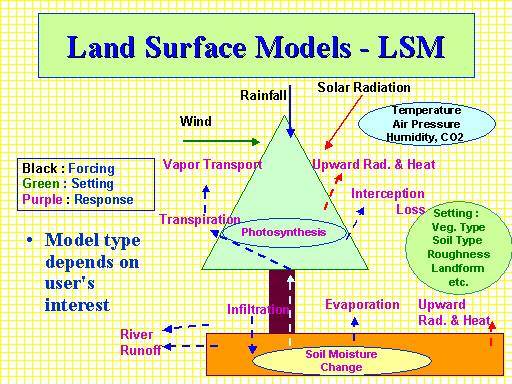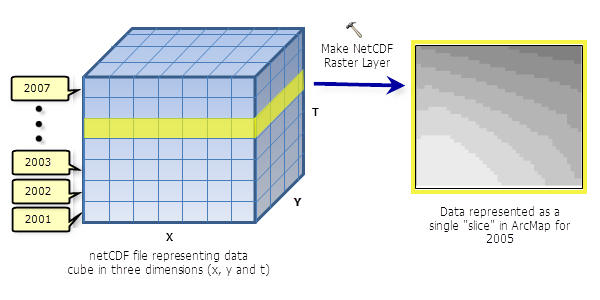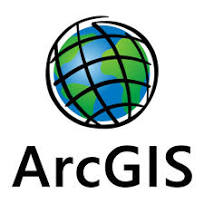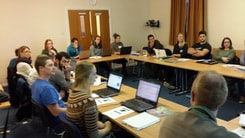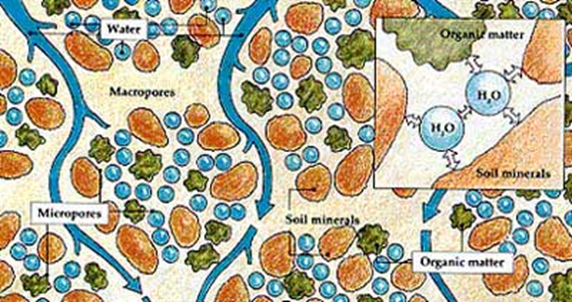I have taught a number of short courses / lecture-style workshops over the years. Here is a brief 'menu' of course material that I can put together into a bespoke short course on request:
|
I have a lot of experience with land surface modelling and could put together an introductory workshop on that topic based on the wide variety of LS simulations I do at UKCEH (see here).
|
|
I spend a lot of my time dealing with gridded datasets (spatial data), e.g. in NetCDF format. Being able to manipulate, transform and visualise gridded data is a fundamental skill for any sort of spatial simulation of climate or the land surface, or for dealing with remote sensing data.
I have quite a lot of material on data visualisation, techniques for editing and transforming NetCDF files, visualisation (inc. making movies), NCO tools, standard grids used at the UK Met Office (Nxxxx global grids, rotated pole grids). I have done a few informal tutorials based on using ArcGIS, but this can be presented using any package. |
|
During 2023 I have presented on many aspects of river flow and runoff representation in models, including aspects of coastal exchange and how coastal flooding is predicted by model simulations. I haven't yet turned this into any sort of course/workshop, but I feel that coupled modelling is a topic of the moment in 2023/24 (as explained by Dr Chris Jones here), so something like that would be well-received.
This work is part of the CHAMFER project led by NOC Liverpool. |
|
Big Data in Environmental Biology
I ran a 4 day long residential course (aimed at doctoral and postdoctoral students) on Generalized Linear Models at Continuing Education, Univ. Oxford, between 2014 and 2020. The last run of this course was in 2020, i.e. Big Data in Environmental Biology and featured lectures from Guido Kraemer from the Max Planck Institut in Jena, Germany, and Thomas Hesselberg from Univ. Oxford as well as presentations from industrial representatives and NERC (this course replaced the Multivariate Ecological Statistics course run with Peter Henderson 2014-2018). In every run of this course so far it was oversubscribed and we have had very good feedback from the students. In future runs of this course I am working on extending the sections on: Bayesian Tools in Ecological Analysis and Supervised vs Unsupervised Machine-learning Tools. |
|
I am a very experienced modeller and have used a wide range of models in the environmental sciences ranging from the land surface model JULES to soil physics models and deforestation prediction models.
JULES is also the only model for which I currently maintain an online tutorial (JULES From Scratch) describing how to port it to and run it on your local server. I am currently presenting this more or less annually on an ad hoc basis as a half-day workshop (last run was Sep 2023 at Univ. Exeter, UK). |
|
As part of my work at Univ. Oxford 2008-15, I helped to develop and extend the RAINFOR-GEM Carbon Monitoring Protocols, which are used widely across the world for C budget calculations.
In 2014, with help from a wide spectrum of colleagues, I put together the RAINFOR-GEM Manual. This provides a complete description of the field methods used across the RAINFOR-GEM network of forest census plots, including initial plot set-up and ongoing measurement of ecosystem carbon components including above-ground live biomass, litter, roots, woody debris and various forms of CO2 efflux. See here for my presentation about these protocols given at the FAO in Rome in Jan 2013. I have informally done some training at UKCEH on the use of these protocols and the importance of forest census plots like those of GEM. - I recorded, with T. Riutta, N. Butt and L. Butt, an online video demonstrating plastic dendrometers in Wytham Woods (2010). - I translated the RAINFOR Field code sheet into Malay with the help of J. Amin, M. Tarongak and K. M. Yusah: link (2011). - Archive version 1.0 of the manual: Metcalfe et al. (2009) - Archive version 2.2 of the manual: Marthews et al. (2012) - Fantastic article about ABERG and the Kosnipata plots in Peru. |
|
Tips and advice for Tropical Fieldwork
This was assembled during 2004-11 and is now a short pdf document. UKCEH Field safety guidelines are here. See here for a VIDEO about the Univ. Oxford Ecosystem Lab's ongoing fieldwork in Peru in 2013 (where I got a few moments of fame). I was also interviewed (while very tired!) at the Maliau Basin in Sabah, Malaysia, while on fieldwork in 2011 (see here, 19 mins in). | |||||||
|
FRIENDLY BEGINNERS' R COURSE:
In the past I regularly presented a course introducing people to the R programming and statistical environment. Since I made the text of this freely downloadable from my website (here), there has been little need for me to present this course. Nowadays I use this in an informal way rather than presenting it myself: the docs are now designed to be done in the user's own time and convenience. Click on the R logo left (or here) → Documentation/Other (left-hand panel) → Contributed Documentation (middle of screen) → Scroll down until you see the "ZIP" next to my name "Marthews" (alternatively, just click here). Since 2010 this course has been used internally by Earthwatch (with permission) and is also linked to from Climate Research Tools. Additionally, since at least 2011 I noticed it has featured on the website of the University of Wisconsin-Madison (although for some reason they just uploaded a version of the pdf without the example files). The lecture-based version of this course was last presented by me in May 2014 at NCBS, Bangalore, India, as part of this workshop and in March 2012 at the R workshop in Ecological Data Analysis at the the BESTEG Early Career Researcher Meeting in Silwood, Imperial College London. Informally, I have been through it a few times since then too, and I have a kind of 'part 2' to it as well now (not uploaded). Although I do admit this course hasn't been updated for a while now, I still recommend it as a relatively painless way to start with R because it is (i) SHORT (at 14 pages it's fairly quick and most comparable introductions are 100s of pages long) and (ii) TO-THE-POINT (I don't go through any theory about how R is 'object-oriented' or 'strongly-typed': I just go through examples of how to do things, with example code fragments. so go download it and try it out! :-) |
|
UNIX BASICS:
A quick guide to the most basic UNIX/Linux commands which I put together in 2008, which is also linked to from Climate Research Tools. Why use UNIX/Linux if you're happy with Windows/Mac? Simply put: (i) If you use anything more than basic computer models you will have to and (ii) I think the UNIX-Haters' Handbook got it right: UNIX is "A horrible system, except that all the other commercial offerings are even worse". | |||||||
I have also given lectures on environmental modelling more generally.
